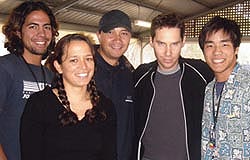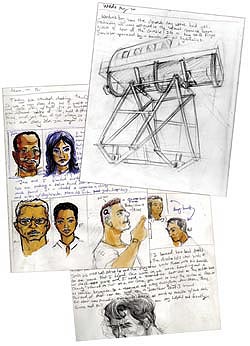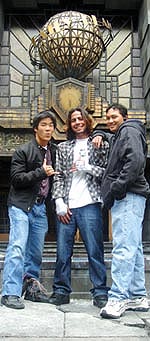Superman’s Return
Internship is a blockbuster experience for four future filmmakers

A moment with Director Bryan Singer (second from right) for interns (from left) Matt Ortiz, Chrystal Jameson, Ronson Akina and Nelson Quan.
What is it like to invest two months on the other side of the globe, participating in the production of a big-budget movie? "It’s all very spectacular, very spectacular!" summarizes Chrystal Jameson. And the payoff is both immediate thrill and long–term career growth.
Jameson and fellow University of Hawaiʻi Academy for Creative Media students Nelson Quan, Ronson Akina and Matthew Ortiz were part of a unique internship that placed them on the set of the summer blockbuster Superman Returns as exclusive production interns. Under the guidance of Chris Lee, ACM director and the movie’s executive producer, they flew to Sydney during summer 2005 to work, learn and explore the field of filmmaking up close and personal. Their entire trip was funded by ACM supporters Roy and Hilda Takeyama, with air travel sponsored by Hawaiian Airlines.

Ortiz used his sketch book to record experiences and memorize names.
The work involved more than getting coffee and making copies. "We were able to bring them down to experience a big–-budget Hollywood picture and every facet of production," says Lee. After two weeks rotating through various production departments, they were invited to participate in the departments they felt most comfortable in as well as doing whatever odd jobs needed to be done and observing how everything ran.
"I really didn’t know what to expect, to be completely honest," Jameson says. "I didn’t realize how many departments it takes to keep everything running. There’re just so many different facets of filmmaking that I was exposed to that I’d never really conceived before. Seeing it all working was, I think, the most magic part—seeing all these different teams from different departments uniting under a common goal, this huge production."
Jameson became involved in assistant directing and the camera department. Ortiz joined the art team, working on the conceptual art and storyboarding of the movie. Work followed the same chronological order as actual scene production. An idea started with the storyboard and concept team. If it did well, it moved on to previews, which is like putting storyboards in animation, and eventually shooting. Ortiz contributed and observed the entire progression from original idea to the filmed version.
"I want to write and direct," says Akina, "so I wanted to shadow Bryan Singer, the director, a little. That’s why they mainly put me with the assistant director department." From the very first day, he helped direct hundreds of extras on the huge Daily Planet newspaper building set. "I felt like I was floating the whole time I was there," he says.

Quan, Ortiz and Akina on the Daily Planet exterior set.
Quan was interested in producing. He was put in the DVD department, responsible for creating special features for the DVD release. He prowled the set with a camera to gather material for the DVD and weblog. And he learned that being the producer’s student doesn’t impart impunity. "I got in trouble once or twice," he confesses. It turns out you’re not supposed to talk to the actors while on set.
"Lee kind of stuck me in this other department and said, ʻNelson, this is what regular interns would do on a regular movie set.’ He made it a point to show me that we’re really privileged to be in an internship like this." In the production department, he filed papers and fetched coffee—"all that stuff, stuff that normal interns get to do. But it was good because as I was filing papers I got to look at the paperwork."
Ortiz also discovered some daunting circumstances. "You have to really make an effort to learn everyone’s names very quickly," he recalls. "There were so many people being introduced everyday, and then you’ll see them again, and it’s like, if you don’t say their name when you shake their hand...!" He found a workaround solution: draw and label some quick sketches of people to aid in memorization. "I’d just write down a few attributes, or maybe I’d rhyme their name with something else. I learned a lot of people’s names that way," he says with a laugh.
Stretches in between shootings could be boring, but the action more than made up for it. "The exciting part is like, when you have to wait and you know they’re going to blow up a car. That was really cool. Or the special effects team would come in, and they’d blow up the Daily Planet," says Quan. "I felt I got to actually do stuff on the set of Superman," he adds. "I would always keep my eye on Bryan Singer and watch him direct, because I want to go into that area."
Was filmmaking what they expected? "No," says Quan, "It was better." The quartet now face new goals and challenges. Ortiz is rethinking whether he wants to go into storyboarding. Jameson and Quan participate in student-operated productions. Akina is part of a filmmaking group that creates independent movies focusing on Hawaiian and local issues.
Pleased with such a strong start for a film intern program, Lee, too, is looking ahead: "We were very glad to extend that sort of opportunity to the four students, which I look forward to offering in the future for other ACM students."